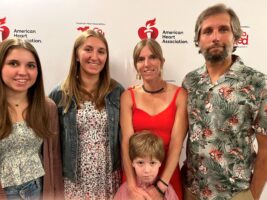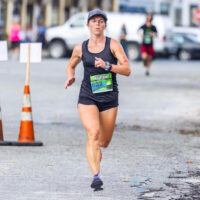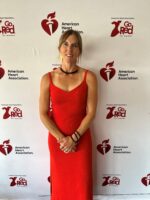October 29th is World Stroke Day. Most adults in the U.S. don’t know the F.A.S.T. warning signs of stroke. New this year, by uploading a selfie and recording your voice, you can see and hear what some common stroke warning signs may look/sound like on you with the American Stroke Association’s new interactive F.A.S.T. experience.
Written by Celina Michael

Celina Michael with her family
My name is Celina McMichael. I have lived in Kennebunk since 2005 with my husband, two daughters and son. We moved here from northern Vermont to live on the seacoast. I am a therapeutic advisor in the mental health field and homeschool my son, while also pursuing my own passions such as long-distance running.
From the outside, looking in, I am the epitome of perfect health and discipline. At 43 now, I have maintained physical exercise, mindfulness practices, and healthy eating habits since I was 18 years old.
I currently run for Tedy’s Team, a non-profit started by stroke survivor Tedy Bruschi – a former New England Patriot. This May, I ran my first post-stroke marathon and will run the New York City marathon in November 2023.
My stroke journey began as a 19-year-old, when I had two strokes separated by about a month – each that presented differently. The first time, my entire left side stopped working. I started to lose vision and speech, but luckily came out of the symptoms very quickly. I felt fine afterward just shaken up, and I did not see a doctor. I did not have a PCP at the time, and I didn’t know the signs and symptoms of stroke.
It didn’t seem quite as bad the second time, but there was a lasting effect on my left arm. It was the year 2000, so it was long before I had access to the internet to research symptoms. It was brought to my attention that it could be my birth control causing these symptoms, so I stopped taking it.
I was admitted to the ER, and the diagnosis came back clear as an ischemic stroke, without any known cause. About 20% of strokes have no known cause.
The neurologist would not say birth control was a “cause” of the strokes but did order me to stop taking them and wanted me to take medication for migraine relief. As soon as I stopped taking birth control, I stopped having migraines. I had no follow up after these two strokes moving forward.
In my 30’s, I began having mini strokes or Transient Ischemic Attacks (TIAs), but they were hard to diagnose as TIAs and migraines are very similar in presentation. My hand would tingle, my face would feel fuzzy and numb, when I would feel a pins and needles feeling. I did head to the ER once with these symptoms and was pretty quickly sent home, told there was no way it was connected to my past, and was checked only for electrolyte levels.
I left the ER with my face and arms still tingling. A few years later I had a very strong TIA that took away my ability to speak for a few seconds or use my left hand. I ended up in the ER again and this time, they found a Patent Foramen Ovale (PFO), which is basically a small hole in the heart. This wasn’t seen as a risk factor at that time or by my doctors, so I was sent on my way again being told it could be anxiety or migraine with aura which is normal for women to have especially around their menstrual cycle.
Two days after my 40th birthday the big one hit after years of hiding my symptoms like tingling hands, numb face, confusion, and dizziness. This time the symptoms were classic: drooping face, lost control of both arms and my left hand stopped completely working from the elbow up. I lost my ability to swallow, was having difficulty breathing, and my voice and speech were greatly affected.
I was only in the hospital for two days after this stroke. My left hand wasn’t working. I could not pick up my phone, grab a tissue or hold anything with my left hand. Surprisingly, I did not qualify for PT, so I sat in my hospital bed staring at my left hand and making it do everything possible even though it was slow and tedious.
Repairing involuntary movements such as the ability to swallow took longer, but my hand only took a few days. I saw a speech therapist once, and I was put on a nectar thick diet for a month because swallowing water or thin substances was challenging and would make me aspirate.
I had another stroke two weeks later and I questioned going to the ER since the symptoms were very slight. I was relieved to hear that the PFO that was dismissed as being normal six years before was now the number one culprit of my stroke and I had it closed in November of 2019. I was told I would never have another stroke again.
I wish that this was the end of my stroke story.
I was fine for only a few weeks after surgery when I felt my first TIA symptoms once again. I knew I should have done something about it, but I didn’t. I called home, I was scared but I did not go to the ER. I called my doctors the next day as I had major aura surrounding both eyes, numbness in the face. My doctors told me these symptoms are normal for women around their menstrual cycle, but I was worried.
In January 2021 I had what was – hopefully – my last stroke. I was in northern Vermont snowboarding with my family. I lost all ability to talk for about five minutes, my face drooped, and I couldn’t swallow.
The first few hours after the stroke were extremely difficult. I couldn’t tell the EMTs my birthday or who was president at the time. Speech was coming back, but my thoughts came slower. I knew I needed to go to the ER but couldn’t advocate strongly as to why. This has been a constant in this journey needing medical attention but not looking like I need medical attention.
We were in the middle of a snowstorm and miles away from a hospital. I was alone, no one allowed in the hospital by my side due to COVID to help navigate my care. But, I know my husband was in close communication. I learned I had suffered a massive stroke.

Celina McMichael at the 2023 Go Red for Women Purse-Onality event in Kennebunkport
This latest stroke was probably the scariest because the PFO closure was supposed to be the answer, but it wasn’t. My story demonstrates that we still need to continue funding research on stroke, especially the type like mine that have no known cause.
I am grateful every day to be here functioning so completely and am searching for ways to support other survivors, their families and especially women or other young stroke survivors that have difficulty mitigating the medical world.
I encourage you all to learn the signs and symptoms of stroke. Remember, if something feels wrong with your body, don’t second guess yourself. Don’t be afraid to ask for a different caregiver, and question everything!
Thank you for helping to fund the work of the American Heart Association and American Stroke Association – it really makes a difference for survivors like me!